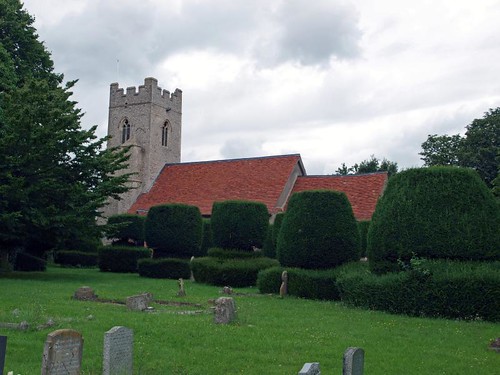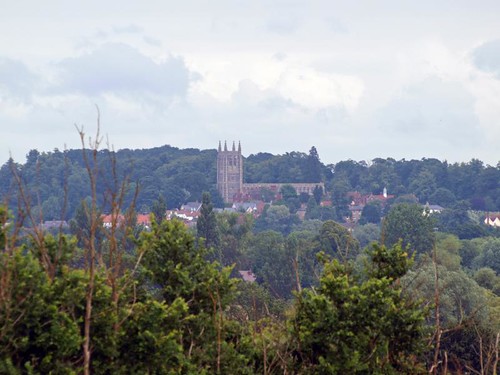The church is surrounded with yew topiary and sits in a beautiful spot - the view across the Stour valley towards Long Melford is stunning.
CHURCH (Dedication unknown). A topiary walk to the porch is the most notable feature of the church. The nave may be C11, see the sw quoin. The chancel and the W tower are Late Perp, the tower with thin diagonal buttresses and stepped battlements. - MONUMENTS. Sir Edward Waldegrave d. 1561 and wife d. 1599. Tomb-chest with recumbent effigies under a six-poster. The columns have shaft-rings. Straight top with big achievement. - Magdala Southcote d. 1592; with big kneeling figure; not good. - Black marble floor slab to Humphrey Burrough d. 1757, rector of Borley and Gainsborough’s uncle.
BORLEY. Its people look across the Stour valley into Suffolk from the churchyard, which has some remarkable clipped yews, like umbrellas with round frills and huge round bases. The church tower, like the chancel and the porch, is Tudor, but the thick south wall of the nave may be 400 years older. There is a bell old enough to have rung for the defeat of the Armada, a 17th century doorway made of wood, a 15th century nave roof with embattled wall-plates, and a little bench with two poppyheads carved 500 years ago. In the chancel we see Magdala Southcote of 1598 kneeling at a desk, and in the nave is the great canopied tomb, 14 feet high, of Sir Edward Waldegrave and his wife Frances, who outlived him by 38 years. At her feet sits a squirrel with its paws to its mouth, and kneeling round the tomb are three sons and three daughters. The canopy rises on six Corinthian columns. Sir Edward was a Tudor Master of the Wardrobe. As an officer of Mary Tudor’s household he was put in the Tower in King Edward’s reign for refusing to prevent the princess from celebrating mass, but was set free on account of his health. On Mary’s coming to the throne he continued to serve her but objected to her marriage with Philip of Spain, so that his feelings were overcome by a pension of 500 crowns. On the accession of Queen Elizabeth he was thrown into the Tower again for allowing mass to be said in his house; and in the Tower he died, being buried in the chapel.
Flickr.
Simon K.
An unlikely knock-on effect of the events at Borley was what happened at nearby Middleton - one might even imagine there was something in the water around here
which led to such shameless self-delusion.
This, from the Observer for 31.12.2000:
In We Faked the Ghosts of Borley Rectory, Louis Mayerling - for whom the house was a second home until its destruction by fire in 1938 - reveals for the first time how the 'hauntings' were created by the rectory's various inhabitants. He describes how they watched in amazement as the world fell for the elaborate hoax.
An investigation carried out by the BBC the year before the fire, when Mayerling was 26, noted more than 2,000 incidents of paranormal activity and concluded that the hauntings were true. The Most Haunted House in England, a book by Harry Price, the most eminent psychical investigator of the time, who lived in the house for a year, cemented the rectory's position as the best documented case of haunting in the annals of psychical research.
'Harry's book became a sort of bible and foundation of knowledge to the thousands who, in that age of psychic phenomena, were keen to believe,' said Mayerling. 'Before long, Borley Rectory stories were practically a daily occurrence in the London newspapers: at the height of it all, we were visited by dozens of coaches packed with ghost-hunters each day. People were coming from as far away as America.
'I would love to say that there was a grain of truth in it all, but I felt that the book had to be written to reveal the farcical truth about the house - as personally experienced.'
George Bernard Shaw, T.E. Lawrence, Sir Montagu Norman, Governor of the Bank of England, and Bernard Spilsbury, the Home Office criminal forensic scientist, were firm believers in the hauntings and attended séances at Borley. Even now, belief in the hauntings has remained so powerful that the case is still held up by believers as incontrovertible proof of the supernatural.
Mayerling arrived in the house, on the Essex-Suffolk border, in 1918 to find the eccentric Rev Harry Bull and his family of 14 children taking active delight in perpetuating local stories of a spectral nun, a family ghost and paranormal activity in the area.
'The house was the embodiment of eccentricities of many kinds,' Mayerling remembered. He reveals in the book how a 'magic piano' that the Bulls claimed was played by spirit hands was in fact activated by the six-year-old Mayerling plucking the piano strings with a poker from the safety of a nearby gap in the wall.
The infamous examples of poltergeist activity were perpetrated by various servants and children who were, Mayerling claims, encouraged by the Bulls to exploit the house's many hidden doors and passages. 'The example of paranormal activity that was given most publicity was the ringing of the servants' bells,' said Mayerling. 'That was simply activated by prodding the servants' bells through the barred windows over the well in the kitchen passage.'
Britain's fascination with Borley peaked in the Thirties, when the Rev Lionel Foyster took over the parish with his wife Marianne. Foyster found it hard to survive on his church stipend of £6 a week, and he and his wife decided that boosting the ghostly reputation of Borley was the best way to make ends meet.
Mayerling, who had returned to live in the house with the Foysters, tells how the couple installed a new water heater which emitted heavy knocking sounds and proclaimed themselves horrified by the noises, and pitted the skirting boards with phosphorus powder which catches fire when exposed to the air.
The couple encouraged Mayerling, still just a teenager, to walk the gardens at dusk in a black cape and turned-up collar - giving birth to the myth of a headless monk who took to writing cryptic messages on the walls of the house.
'Probably to save costs at Borley, sea-sand had been used in the walls in place of the regulation material. This caused a permanent dampness which swallowed up anything written on them in a matter of hours,' Mayerling said. 'Nevertheless, many scholars recognised the wall-writings as being genuine poltergeist activity and they were illustrated in the press across the world, adding a great stimulus to psychical research and Spiritualism.'
Simon K.
Borley is a tiny hamlet not far from the high street of the large Suffolk
village of Long Melford. It became, in the 1930s, the focus of
notoriety thanks to the activities of a conman and self-proclaimed
'ghost hunter' called Harry Price. Price elaborated on the hoaxing and
spoofing of the successive Rectors and their families of the time. As
a result of his books, Borley Rectory became known as 'the most
haunted house in England'. The hokum and fakery still attract a
lunatic fringe of sensation-seekers with nothing better to do, and
hence the church is ordinarily kept locked, unusually for north Essex.
This, from the Observer for 31.12.2000:
In We Faked the Ghosts of Borley Rectory, Louis Mayerling - for whom the house was a second home until its destruction by fire in 1938 - reveals for the first time how the 'hauntings' were created by the rectory's various inhabitants. He describes how they watched in amazement as the world fell for the elaborate hoax.
An investigation carried out by the BBC the year before the fire, when Mayerling was 26, noted more than 2,000 incidents of paranormal activity and concluded that the hauntings were true. The Most Haunted House in England, a book by Harry Price, the most eminent psychical investigator of the time, who lived in the house for a year, cemented the rectory's position as the best documented case of haunting in the annals of psychical research.
'Harry's book became a sort of bible and foundation of knowledge to the thousands who, in that age of psychic phenomena, were keen to believe,' said Mayerling. 'Before long, Borley Rectory stories were practically a daily occurrence in the London newspapers: at the height of it all, we were visited by dozens of coaches packed with ghost-hunters each day. People were coming from as far away as America.
'I would love to say that there was a grain of truth in it all, but I felt that the book had to be written to reveal the farcical truth about the house - as personally experienced.'
George Bernard Shaw, T.E. Lawrence, Sir Montagu Norman, Governor of the Bank of England, and Bernard Spilsbury, the Home Office criminal forensic scientist, were firm believers in the hauntings and attended séances at Borley. Even now, belief in the hauntings has remained so powerful that the case is still held up by believers as incontrovertible proof of the supernatural.
Mayerling arrived in the house, on the Essex-Suffolk border, in 1918 to find the eccentric Rev Harry Bull and his family of 14 children taking active delight in perpetuating local stories of a spectral nun, a family ghost and paranormal activity in the area.
'The house was the embodiment of eccentricities of many kinds,' Mayerling remembered. He reveals in the book how a 'magic piano' that the Bulls claimed was played by spirit hands was in fact activated by the six-year-old Mayerling plucking the piano strings with a poker from the safety of a nearby gap in the wall.
The infamous examples of poltergeist activity were perpetrated by various servants and children who were, Mayerling claims, encouraged by the Bulls to exploit the house's many hidden doors and passages. 'The example of paranormal activity that was given most publicity was the ringing of the servants' bells,' said Mayerling. 'That was simply activated by prodding the servants' bells through the barred windows over the well in the kitchen passage.'
Britain's fascination with Borley peaked in the Thirties, when the Rev Lionel Foyster took over the parish with his wife Marianne. Foyster found it hard to survive on his church stipend of £6 a week, and he and his wife decided that boosting the ghostly reputation of Borley was the best way to make ends meet.
Mayerling, who had returned to live in the house with the Foysters, tells how the couple installed a new water heater which emitted heavy knocking sounds and proclaimed themselves horrified by the noises, and pitted the skirting boards with phosphorus powder which catches fire when exposed to the air.
The couple encouraged Mayerling, still just a teenager, to walk the gardens at dusk in a black cape and turned-up collar - giving birth to the myth of a headless monk who took to writing cryptic messages on the walls of the house.
'Probably to save costs at Borley, sea-sand had been used in the walls in place of the regulation material. This caused a permanent dampness which swallowed up anything written on them in a matter of hours,' Mayerling said. 'Nevertheless, many scholars recognised the wall-writings as being genuine poltergeist activity and they were illustrated in the press across the world, adding a great stimulus to psychical research and Spiritualism.'
The real ghosts of Borley, of course, are the Waldegrave family, lords
of the manor in late medieval times, and memorialised in wide-eyed
terror in effigy on their rustic tomb of about 1600.


No comments:
Post a Comment